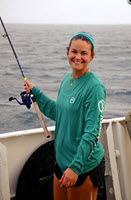
Responders to the 2010 Deepwater Horizon incident sought to reduce the amount of shoreline oiling by diverting an increased amount of Mississippi River outflow into the Gulf of Mexico. The Army Corps of Engineers opened the Bonnet Carré Spillway in 2016, which diverted Mississippi River water into the Mississippi Sound, to relieve pressure on the Louisiana levee system following heavy rainfall. While these actions may have been necessary, surges of freshwater and nutrients into coastal and shelf waters can place stress on the marine environment.
Angie Hoover wants to know how large freshwater pulses and other environmental stressors affect the diet, growth, and condition of larval fishes. “The main motivation behind my work is to do something that betters the planet,” said Angie. “There is a lot of anthropogenic-sourced stress on the Earth, and I want to provide data and information that can help mitigate these issues.”
Angie is a master’s student with the University of Southern Mississippi’s Division of Coastal Sciences and a GoMRI Scholar with the Consortium for Oil Spill Exposure Pathways in Coastal River-Dominated Ecosystems (CONCORDE).
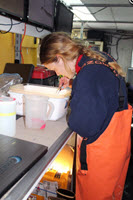
Her Path
Angie grew up in a landlocked Oklahoma town, so she asked that her family vacation at the beach where she could explore the seashore. That desire remained with her, and when she began her undergraduate degree, she never considered a career path other than studying the ocean and its organisms. “I have always found myself wondering how organisms interact with each other and their environments,” said Angie. “The connections formed between organisms and the complexity of marine habitats and food webs especially piqued my interest.”
Angie completed an undergraduate degree in biology at Southwestern Oklahoma State University, which had coastal connections through a partnership with the University of Southern Mississippi (USM). She spent two summers taking classes at USM’s Gulf Coast Research Laboratory where she later began a coastal sciences master’s degree in Dr. Frank Hernandez’s fisheries oceanography and ecology lab.
Her Work
Angie is investigating how the resulting hydrographic changes after the Bonnet Carré diversion and hypoxic zones affect important survival factors such as diet, growth, and condition in larval fish species. “Because riverine diversions were used to keep the oil offshore after Deepwater Horizon, understanding how diversions impact larval fish, especially those important to the fisheries industry, will be important if they are used for future spill response,” she said.
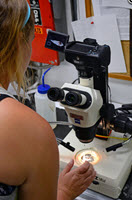
CONCORDE researchers identified water masses in the Mississippi Sound/Chandeleur Sound, Mobile Bay, and Birdsfoot Delta to compare the prey field (zooplankton), diet, growth, and condition of Gulf menhaden (Brevoortia petronus) across different physical and biological environments. Angie and her colleagues conducted a research cruise shortly after the Bonnet Carré opening to capture fish specimens using a paired bongo net and later sorted the plankton samples for fish larvae.
Angie’s first research goal uses Gulf menhaden to identify potential impacts of diversion-driven changes to Mississippi Sound hydrography. Gulf menhaden were abundant in all of her team’s samples and provided a useful sample size for comparison studies among water masses. Angie imaged and measured the Gulf menhaden larvae and removed their guts and otoliths (an inner ear bone that reflects a fish’s growth). She identified and counted the gut contents to determine the fish’s diets and weighed and measured the fish to determine each organism’s condition.
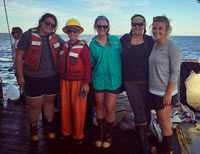
Angie’s findings so far show that although larvae diets were not statistically different among water masses, growth and condition did vary significantly. The abundance and community composition of their zooplankton prey differed in the northern Mississippi Sound/Chandeleur Sound compared to Mobile Bay and Birdsfoot Delta. She explained that freshwater influxes can cause changes in temperature and salinity that alter the planktonic communities that larval fish prey upon, potentially leading to reductions in the larvae’s growth and condition.
Angie’s next step will be to investigate how a different environmental stressor, seasonally occurring coastal hypoxia, influences larval fish diet, growth, and condition. During a summer research cruise, she used a multinet plankton sampler to collect plankton at different depths in the water column, including hypoxic and normoxic environments. She will compare the diet, growth, and condition of larvae collected from hypoxic water to those in water with normal oxygen levels to determine if hypoxia played a role in any observed differences.
Her Learning
Working with Dr. Hernandez provided Angie with valuable experience and knowledge about the various aspects of scientific research. Through her work, she learned not only technical skills such as field sampling techniques, sample processing, and species identification, but also important networking and communication skills to share her research and collaborate with other scientists. “Throughout my years at USM, I gained a better understanding of the metrics and analyses used in the field of larval fish ecology, what is feasible and important for developing a project, and how to write and communicate my science effectively and efficiently,” she said.
Angie faced her struggles with public speaking head-on at the 2017 Gulf of Mexico Oil Spill and Ecosystem Science Conference in New Orleans, Louisiana. The conference was her first oral presentation to expert researchers – a particularly intimidating situation for her. “Being able to successfully present my work and answer questions from the GoMRI community helped me see myself as a part of the scientific community rather than just another student,” she explained. “It was a breakthrough I needed to experience, and GoMRI provided the platform.”
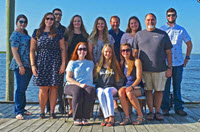
Her Future
Angie’s graduate school experiences strengthened her love for ocean sciences and her interest in deciphering data. She hopes to find a laboratory or agency technician position and expand her skills and knowledge about the interactions between anthropogenic disturbances and fisheries ecology and oceanography. She suggests that students interested in a scientific career should expand their traditional ideas about a scientific career path and make their own opportunities. “As someone with little to no aquatic experience who spent the majority of her life in a landlocked state, I have learned that everyone’s path is different,” she said. “As long as you are taking as much action as possible to build your skills and knowledge base and are passionate about succeeding in your field, you will get your chance.”
Praise for Angie
Dr. Hernandez described Angie as a tremendous asset to his lab and to CONCORDE research. He said that her research on larval fish diet, growth, and condition exceeds their originally proposed research objectives. “She has excelled both at sea collecting data and in the laboratory processing samples,” he said. “She has a tremendous work ethic, a strong commitment to her research, and the respect of all of her lab mates – especially her mentor.”
The GoMRI community embraces bright and dedicated students like Angie and their important contributions. The GoMRI Scholars Program recognizes graduate students whose work focuses on GoMRI-funded projects and builds community for the next generation of ocean science professionals. Visit the CONCORDE website to learn more about their work.
************
The Gulf of Mexico Research Initiative (GoMRI) is a 10-year independent research program established to study the effect, and the potential associated impact, of hydrocarbon releases on the environment and public health, as well as to develop improved spill mitigation, oil detection, characterization and remediation technologies. An independent and academic 20-member Research Board makes the funding and research direction decisions to ensure the intellectual quality, effectiveness and academic independence of the GoMRI research. All research data, findings and publications will be made publicly available. The program was established through a $500 million financial commitment from BP. For more information, visit https://gulfresearchinitiative.org/.
© Copyright 2010-2017 Gulf of Mexico Research Initiative (GoMRI) – All Rights Reserved. Redistribution is encouraged with acknowledgement to the Gulf of Mexico Research Initiative (GoMRI). Please credit images and/or videos as done in each article. Questions? Contact web-content editor Nilde “Maggie” Dannreuther, Northern Gulf Institute, Mississippi State University (maggied@ngi.msstate.edu).
